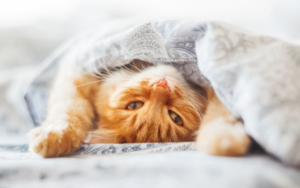
According to business data platform Statista, there are around 11 million cats in the UK in 2023. With cats being popular in households across the UK we look at how to best protect your cat should it require medical treatment due to an illness or injury.
In this article, we take a look at cat insurance, including what it covers, how much it costs and whether cat insurance is worth it. We also look at the best cat insurance providers in the UK and explain how you can pay from as little as £3.35 a month** with comparison site, Quotezone* for your cat insurance.
If you have a dog at home you may also wish to look at the best dog insurance in the UK to compare some of the best dog insurance providers.
1 minute summary
- Cat insurance is designed to cover the cost of veterinary fees in the event your cat falls ill unexpectedly.
- There are four main types of cat insurance; lifetime, maximum benefit, time-limited and accident-only.
- For the most comprehensive cover, lifetime and maximum benefit cat insurance will cover long term and chronic conditions.
- If you are looking for cover but wish to pay less, time-limited and accident-only may be a better choice.
- The best way to search for a cat insurance policy is via a comparison site such as Quotezone* as you can compare several cat insurance providers at once to find the best cover for your cat.
What is cat insurance?
Cat insurance is a pet insurance policy designed to cover your pet in the event of a large and unexpected veterinary bill. There are four main types of pet insurance and each type offers different levels of cover for your cat. We go into more detail below in the section titled ‘What are the different types of cat insurance?‘.
With pet insurance for cats, you pay a monthly or annual premium to the insurer and then if you need to make a claim you pay an excess fee (which you will have selected at the start of the policy) and the insurer should cover the remaining veterinary fee costs up until the maximum veterinary fee amount. The best pet insurance you can buy for cats is a lifetime pet insurance policy. This is because it covers your cat for illness and injury for the duration of its life, which offers peace of mind as your pet ages. Some cat insurance policies such as time-limited pet insurance, impose time limits on how much you can claim but this type of policy can be more suitable if you do not want to pay a lot for your cat insurance premium.
For more information on pet insurance read our ‘Complete guide to pet insurance'.
What does cat insurance cover?
What your cat is covered for will depend on the cat insurance policy you choose. Lifetime pet insurance typically offers the most comprehensive cover for your pet. More information on the different types of policy can be found below in the section titled “What are the different types of cat insurance?“.
A typical cat insurance policy will insure your pet for the following:
Veterinary fees for illness or injury
Death/loss of your cat
Cattery fees should you be hospitalised in an emergency
A typical cat insurance policy will not cover your pet for the following:
Routine treatment
Neutering
Routine dental treatment
Pre-existing conditions
Find the right Pet Insurance for you
Our partner Quotezone will compare quotes from over 15 UK pet insurance providers
- You could pay from £3.35 per month**
What are the different types of cat insurance?
There are four main types of pet insurance and below we summarise the key differences between the policies.
Lifetime pet insurance
Lifetime pet insurance is the most comprehensive pet insurance policy for your cat as it will cover your cat up to a set amount each year for the duration of its life. If you make a claim on a lifetime pet insurance policy the veterinary fee cover amount renews the following year as long as you continue to pay the premium.
There are two types of lifetime pet insurance, annual limit and annual limit per condition. Annual limit lifetime pet insurance insures your pet for a set veterinary fee amount each year, which means you can claim for multiple conditions each year up to the vet fee limit. Once the limit has been reached any further treatment will need to be self-funded until the limit resets the following policy year. Annual limit per condition lifetime pet insurance works in the same way as annual limit lifetime insurance except that your pet is insured for a set amount per condition per policy year.
For more information on lifetime pet insurance and to compare some of the best lifetime pet insurance providers, read our articles:
Maximum benefit pet insurance
Maximum benefit pet insurance is not as comprehensive as lifetime pet insurance as the vet fee cover does not renew annually. Despite this, it is still a good level of cover for your cat as it will insure your cat for a set amount per condition. There is no time limit on claiming for the condition and if you have a sizeable amount of veterinary fee cover this could cover your pet for a long-term condition.
To find out more about maximum benefit pet insurance and compare the best providers, read our articles:
Time-limited pet insurance
Time-limited pet insurance is usually one of the cheaper pet insurance policies – that insures your pet for accidents and illness – because it limits how long you have to make a claim for a particular condition. With time-limited pet insurance you will be insured for a set amount per condition and for a set period of time, whichever comes first. The most your pet is usually insured for is 12 months from the onset of the condition or from the first date of treatment. If you reach the condition limit, or 12 months pass, any further treatment for the condition will need to be self-funded.
For more information on time-limited pet insurance and to find the best providers, read our articles:
Accident-only pet insurance
Accident-only pet insurance insures your pet for a set amount for accidents – such as being hit by a car – and does not cover the cost of any treatment due to an illness. As it only insures your cats for an accident, it is usually one of the cheapest pet insurance policies. Some accident-only pet insurance providers enforce a 12-month time limit on how long you have to claim for the accident, but this is policy dependent.
For more information on accident-only pet insurance and to compare some of the best insurers, read our articles:
Do you need pet insurance for cats?
Cat insurance is an insurance product designed to help pay for large and unexpected veterinary bills, helping to reduce financial stress in the unfortunate event that your cat is unwell. Pet insurance enables owners to seek the proper treatment that their pet needs; treatment that may be unaffordable in the absence of a pet insurance policy. Some insurers even allow the treatment to be pre-authorised, giving owners the assurance that it is definitely covered when it comes to claiming on the policy.
Cat insurance can seem expensive if your cat is relatively healthy but it can quickly pay for itself should you need to make a claim. You may be wondering if it is worth insuring your cat, particularly if your cat is an indoor cat and doesn't go outside. Some insurers may see indoor cats as less of a risk to insure as they are less likely to be involved in an accident such as being hit by a car, and this, in turn, could mean your pet insurance premium is cheaper. If your pet insurance policy requires you to state whether your cat is an indoor or outdoor cat it is worth considering that in most cases they would not be covered for any treatment for accidents that occurred outside, so be sure to check your policy documents carefully so you know exactly what you are covered for.
Additionally, as your cat ages, it is more likely to develop an illness and therefore your chances of needing veterinary treatment increase. A study by the Royal Veterinary College, in partnership with the emergency pet service VetsNow, found that cats aged between 6 months and 6 years were more likely to be involved in a road traffic accident with male cats and crossbred cats the most likely to be involved in a road traffic accident. So while your younger cat is less likely to need treatment for an illness, it may be a good idea to take out pet insurance to insure your pet for any treatment as a result of an accident.
The best pet insurance for cats
Choosing the right pet insurance policy for your cat can be overwhelming, particularly as there are a host of pet insurance providers that offer cover for your cat. The first thing to look at when choosing a policy is whether the policy covers everything you need. Read our article ‘What are the different types of pet insurance?‘ to compare the different policy types to help you decide which cover type is best for you.
In the below comparison table, we share some of the best cat insurance providers in the UK.
The best cat insurance providers
Scroll to the right to view the full table
| Agria* | Animal Friends | ManyPets* | Waggel* | Petsure* | Direct Line | Scratch & Patch | The Insurance Emporium | |
| Policy types | Lifetime | Lifetime
Maximum benefit Time-limited Accident only |
Lifetime | Lifetime | Lifetime | Maximum benefit
Time-limited |
Lifetime
Maximum benefit Time-limited Accident only |
Lifetime
Maximum benefit Time-limited Accident only |
| Maximum vet fee cover (policy dependent) | Up to £20,000 |
Up to £18,000 |
Up to £15,000 |
Up to £15,000 | Up to £15,000 | Up to £8,000 |
Up to £8,000 |
Up to £8,000 |
| Multi-pet discount | 5% | No | Up to 15% | No | No | 12.5% | 10% | 10% |
| Online discount | No | No | No | No | No | Introductory online discount for new customers.
If you already have another insurance policy (e.g. car insurance) with Direct Line you will also get a discount |
No | Introductory online discount |
| Free vet video calls/helpline | Yes | Yes | Yes | Yes | Yes | Yes | Yes | No |
| Good for… | breeders | choice of policy | multi-pet discount | Simplicity | Option for no excess | discounted medication | choice of whether to have co-payment | senior cats |
| More info | Agria pet insurance review | Animal Friends pet insurance review | ManyPets pet insurance review | Waggel pet insurance review | Petsure pet insurance review | Direct Line pet insurance review | Scratch & Patch pet insurance review | The Insurance Emporium pet insurance review |
How much is cat insurance?
The below comparison table highlights the cost of a cat insurance policy with some of the top cat insurance providers. We have compared the most comprehensive pet insurance policies with each of the providers. The quotes are based on a 1-year-old mixed breed cat living in the South East with no underlying health conditions. It is worth noting that individual quotes are likely to vary depending on the breed and age of your cat. Typically, pedigree cats are more expensive to insure than mixed breed cats as they are more susceptible to certain illnesses associated with the breeds. For more information on the cost of pet insurance, read our article ‘How much does pet insurance cost?‘
How much does cat insurance cost?
| Agria* | Animal Friends | ManyPets* | Waggel* | Petsure* | Direct Line | Scratch & Patch | The Insurance Emporium | |
| Policy type | Annual limit lifetime | Annual limit lifetime |
Annual limit lifetime | Annual limit lifetime | Annual limit lifetime | Maximum benefit | Annual limit lifetime | Annual condition limit lifetime |
| Policy name | Agria Lifetime Premium | Lifetime-£18,000 | Complete | Lifetime | Lifetime | Advanced Cover | Premier Plus | Lifetime Gold |
| Max veterinary fee cover | £20,000 per year | £18,000 per year | £15,000 per year | £15,000 per year | £15,000 per year | £8,000 per condition | £8,000 per year | £8,000 per condition per year |
| Policy excess | £95 plus 10% co-payment | £99 | £99 | £100 | £100 | £80 | £125 | £175 plus 5% co-payment up to £20,000 and 25% thereafter |
| Monthly cost 1-year-old cat | £38.68 | £48.69 | £33.20 | £43.59 | £55.85 | £19.12¹ | £20.79 | £17.17¹ per Lunar month (every 28 days) |
(Quotes correct as of 07/01/25) ¹includes introductory discount
How to reduce the cost of cat insurance
The cost of your cat insurance policy will depend on a variety of factors such as the age and breed of your cat. Where you live and the type of pet insurance policy you choose will also affect the premium cost. For more information on what affects the cost of pet insurance read our article ‘7 factors that affect the cost of pet insurance‘. Your cat is likely to be cheaper to insure when it is younger as you are less likely to claim on your policy for an illness so it is best to open a policy when your pet is young. However, if you do purchase a cat insurance policy when your pet is young and you do need to claim, be aware that the condition may not be covered if you decide to switch insurers at a later date.
Below, we share some ways you can potentially reduce your pet insurance policy:
- Take advantage of a multi-pet policy if you have more than one pet in your household
- Get your pet neutered/spayed to reduce associated medical problems and the risk of straying
- Pay a higher policy excess or add a co-payment to increase the amount you contribute towards the cost of the claim, this, in turn, reduces the policy premiums
For more money-saving tips, read our article, ‘How to save money on pet insurance‘.
Pros and cons of cat insurance
Pros of cat insurance
- Helps cover unexpected veterinary bills
- Can be cheaper to insure an indoor cat
- Can contribute towards the cost of a lost cat
- Can cover your pet for long-term and chronic illnesses (if you choose lifetime pet insurance)
Cons of cat insurance
- Can be expensive if you do not need to make a claim
- Does not cover routine treatment such as vaccinations and worming
- Does not cover neutering
- Does not cover pre-existing conditions
How to buy cheap cat insurance
If you are looking to buy a pet insurance policy for your pet you could save time and money by using a comparison site such as Quotezone* or MoneySuperMarket*. This allows you to easily compare numerous cat insurance providers and find the policy that best suits your needs. It is worth considering that when comparing cat insurance products via a comparison site you may be able to get a cheaper deal with the insurer direct so ensure that you do your own research. Some cat insurance policies are also sometimes cheaper via a comparison site because the policy has a higher excess or additional co-payment added to the policy. This means that you will be paying more when it comes to making a claim which, in turn, lowers your monthly premiums.
It is best to thoroughly research when looking for the right insurance product for your cat as it is easy to get caught out by exclusions within the policy wording. Always ensure you check the policy documents carefully before taking out a cat insurance policy.
If a link has an * beside it this means that it is an affiliated link. If you go via the link, Money to the Masses may receive a small fee which helps keep Money to the Masses free to use. The following link can be used if you do not wish to help Money to the Masses or take advantage of any exclusive offers – Quotezone, ManyPets, Agria, MoneySuperMarket, Waggel, Petsure




